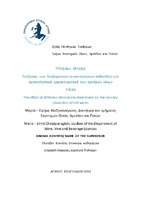| dc.contributor.advisor | Κουσίση, Ελισάβετ | |
| dc.contributor.author | Χατζηπαναγιώτη, Μαρία - Ειρήνη | |
| dc.date.accessioned | 2023-01-09T10:43:17Z | |
| dc.date.available | 2023-01-09T10:43:17Z | |
| dc.date.issued | 2022-09-30 | |
| dc.identifier.uri | https://polynoe.lib.uniwa.gr/xmlui/handle/11400/3552 | |
| dc.identifier.uri | http://dx.doi.org/10.26265/polynoe-3392 | |
| dc.description.abstract | Οι οίνοι χαμηλής περιεκτικότητας σε αιθανόλη, καθώς και οίνοι χωρίς αλκοόλ γνωρίζουν σημαντική και σταδιακή ανέλιξη στη σύγχρονη εποχή, αποκτώντας ένα ευρύ καταναλωτικό κοινό με διαφορετικές ανάγκες και απαιτήσεις. Η αιθανόλη, ως βασικό συστατικό, δείχνει να επηρεάζει τα οργανοληπτικά τους χαρακτηριστικά, άλλοτε θετικά και άλλοτε αρνητικά. Στην παρούσα διπλωματική εργασία, θελήσαμε να μελετήσουμε την επίδραση διαφορετικών συγκεντρώσεων αιθανόλης στα οργανοληπτικά χαρακτηριστικά των ερυθρών οίνων. Συγκεκριμένα, χρησιμοποιώντας έναν ερυθρό, γλυκύ οίνο βάσης με αρχική συγκέντρωση 5% σε αιθανόλη, και με προσθήκη ανάλογων ποσοτήτων αιθανόλης γεωργικής προέλευσης , παρασκευάσαμε άλλα τρία (3) δείγματα με αλκοολικό τίτλο 8, 11 και 14% αντίστοιχα. Τα δείγματα αυτά διατηρήθηκαν σε θερμοκρασία 15.7 βαθμών Κελσίου και μετά από έναν μήνα ακριβώς, η ομάδα δοκιμαστών του τμήματος Επιστημών, Οίνου, Αμπέλου και Ποτών, πραγματοποίησε εις διπλούν οργανοληπτική αξιολόγηση σε αυτά. Στη συνέχεια, τα τέσσερα (4) δείγματα, μετά από κατάλληλη προετοιμασία, επεξεργάστηκαν μέσω αέριας χρωματογραφίας – φασματομετρίας μάζας, για την ανίχνευση των πτητικών ουσιών του οίνου. Σε τελικό στάδιο, επεξεργαστήκαμε μέσω μονόδρομης και αμφίδρομης ανάλυσης της διακύμανσης τα αποτελέσματα της οργανοληπτικής αξιολόγησης και των πτητικών συστατικών που ποσοτικοποιήθηκαν. Παρατηρήθηκε ότι η αιθανόλη είχε σημαντική επίδραση στην πικρή γεύση και τη θερμαντική επίγευση, κάνοντάς τες πιο έντονες στο δείγμα με 14% περιεκτικότητα. Το ίδιο συνέβη και με τα γήινα αρώματα στόματος, των οποίων η αντίληψη ήταν επίσης πιο έντονη στο δείγμα αυτό. | el |
| dc.format.extent | 63 | el |
| dc.language.iso | el | el |
| dc.publisher | Πανεπιστήμιο Δυτικής Αττικής | el |
| dc.rights | Αναφορά Δημιουργού - Μη Εμπορική Χρήση - Παρόμοια Διανομή 4.0 Διεθνές | * |
| dc.rights | Attribution-NonCommercial-NoDerivatives 4.0 Διεθνές | * |
| dc.rights.uri | http://creativecommons.org/licenses/by-nc-nd/4.0/ | * |
| dc.subject | Οίνος χωρίς αλκοόλ | el |
| dc.subject | Αιθανόλη | el |
| dc.subject | Εστέρες | el |
| dc.subject | Οργανοληπτικός έλεγχος | el |
| dc.subject | Οίνος χαμηλής περιεκτικότητας σε αλκοόλ | el |
| dc.title | Η επίδραση των διαφορετικών συγκεντρώσεων αιθανόλης στα οργανοληπτικά χαρακτηριστικά των ερυθρών οίνων | el |
| dc.title.alternative | The effect of different ethanol concentrations on the sensory characters of red wines | el |
| dc.type | Πτυχιακή εργασία | el |
| dc.contributor.committee | Ντουρτόγλου, Ευθαλία | |
| dc.contributor.committee | Παρασκευόπουλος, Ιωάννης | |
| dc.contributor.faculty | Σχολή Επιστημών Τροφίμων | el |
| dc.contributor.department | Τμήμα Επιστημών Οίνου, Αμπέλου και Ποτών | el |
| dc.description.abstracttranslated | Low alcohol and non-alcohol wines show a significant and progressive growing trend nowadays, gaining a large number of consumers with various needs and demands. Ethanol, as the basic component, seems to have sometimes a positive and other times a negative effect on their sensory characters. The aim of this thesis was to study the effect of different ethanol concentrations on the sensory characters of a red wine. In particular, by using a sweet red wine of 5% v/v initial ethanol concentration as base, with the addition of corresponding quantities of ethanol of agricultural origin, we prepared three (3) more samples with a final alcohol percentage of 8, 11 and 14% v/v respectively. These samples were stored at a temperature of 15.7˚C and after one month precisely, the tasters’ team of the Department of Wine, Vine and Beverage Sciences, carried out a sensory evaluation in the samples twice. Then, the four (4) samples, being properly prepared, were analysed with gas chromatography – mass spectrometry (GC-MS), for the detection and quantification of their volatiles. During the final stage, we processed by one and two-way analysis of variance the results of the sensory evaluation and of the volatile substances which were quantified. It was concluded that ethanol had a significant effect on the bitter taste and the warming aftertaste of the wines, making them more intense in the sample with 14% v/v final ethanol concentration. The same happened with the earthy aromas in the mouth, which also had a more intense perception in the 14% v/v concentration sample. | el |


